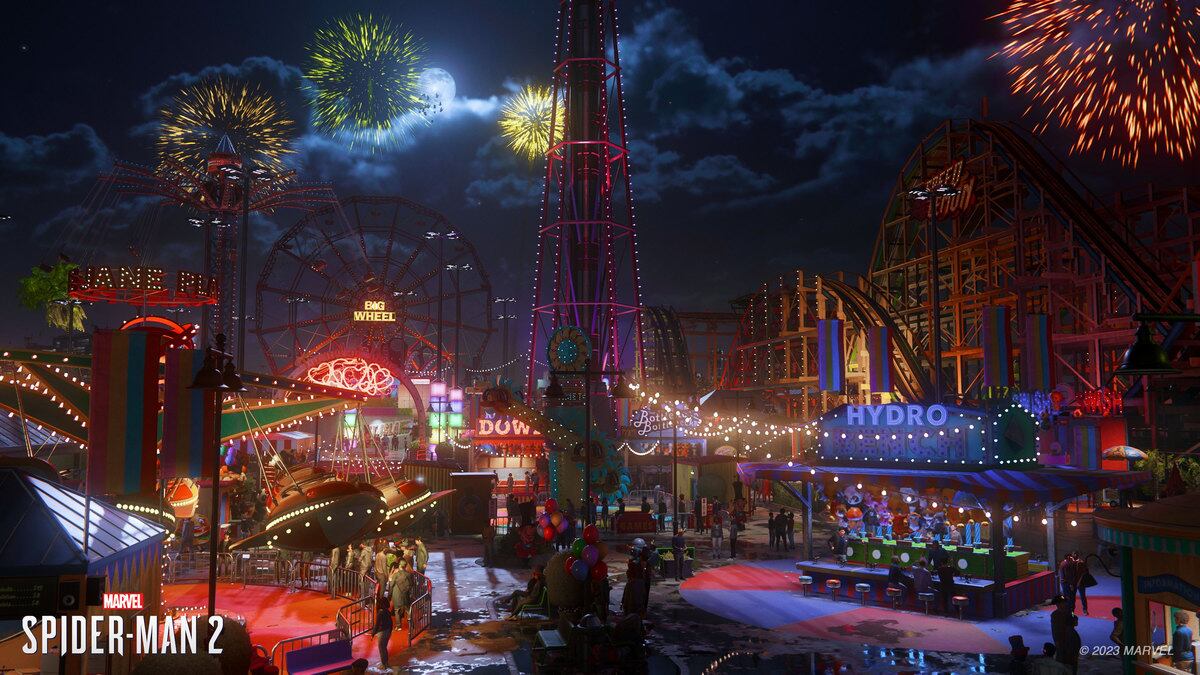What does a superhero do when they are not out, well, superheroing?
This is a question that developers at Insomniac Games took on with style in Marvel’s Spider-Man 2, while recreating an iconic New York City location.
While many players of the new PlayStation 5 game (released on Oct. 20) quickly found themselves enamored by the ability to soar and swing through Manhattan (and, now, Brooklyn and Queens) or go toe-to-toe with the beloved villain Venom, I found myself drawn to one of its quieter moments: one where Peter Parker got to be just Peter Parker. Well, at least, at first.
Early on into the game’s story, Peter goes on a whirlwind, nostalgia-filled adventure through Coney Island with his best friend Harry Osborn—who has re-emerged after several years sick at home, seemingly cured from the hereditary condition that killed his mother—and girlfriend Mary Jane Watson. It’s a stunning, emotional sequence that will fill anyone who spent any time at an amusement park or carnival as a kid with glee.

However, what makes it even more impressive is the fact that players can not only interact with several classic carnival games, but they can even actually hop on some of the rides at this iteration of Coney Island. This includes a roller coaster, where players can make Peter throw his hands up in joy—the only way to truly ride a roller coaster, after all.
And after speaking with Insomniac Games’ senior game director Ryan Smith, senior art designer Jacinda Chew, and advanced senior writer Lauren Mee, it became clear that the scope of this chunk of story was quite a challenging undertaking.
The three developers chatted with The Daily Beast’s Obsessed about the work that went into creating the game’s own Coney Island, how it originally was less interactive, and why it was always going to serve an important narrative role.
[Warning: Spoilers ahead for Marvel’s Spider-Man 2.]
This interview has been edited for clarity and length.
Peter, MJ, and Harry’s trip to Coney Island led to some of the game’s more pivotal, emotional moments. What was special about writing this sequence?
Lauren Mee: The really nice thing about this sequence is that it was built around designer Christina Curlee’s concept of the mission: What do our heroes’ lives look like on a perfect night? And that gave us a baseline. For myself and a couple other writers—Rob Forman and Brittney Morris—it was really exciting to look into the concept of nostalgia. When you’re a superhero, it’s not like you get to stop and smell the roses all that often.

You really don’t! It was nice seeing Peter Parker and Mary Jane Watson just be normal 20-somethings during this part. I think we often forget how young they both really are.
Mee: Even though they’re so young, because they’ve been through so much, they’re re-experiencing childlike wonder. But even then, there are still moments when they look at certain games or rides, and they’re like, “Oh, I’m too old for that, or I’m too big for that.”
Speaking of the rides and games, I loved that you could actually play the games and even go on rollercoaster rides. Why did you decide to make it a playable part of the game?
Ryan Smith: From the player standpoint, it really sells that experience for you. It gives you that experience that you can’t get in a lot of other games, and it really gives us that time to make those connections with the characters that Lauren was talking about. Every little bit of interaction that you have where you’re doing something fun as a player, we also have that time that [the player, as Peter] is spending with your friends. Putting that all together and making it a playable experience, really let us build those character connections that are so important for this moment and for the rest of the game.

What was the decision-making process for which rides and games to include?
Smith: There were definitely a bunch of [questions], like: What games do they actually have? What games do we all imagine they have? What triggers our nostalgia? Then we had to look a little bit at how we can bring that to life for the player. There’s the basketball game... some were gonna be one-offs, like the Hydra Head Hitters.
[The question was,] does it feel authentic? Does it have a fun player interaction that we can imagine? Or a really great storytelling element?
I loved when MJ was smacking the crap out of those Hydra Heads. She had frustration, and she was letting it out! Very relatable.
Mee: That was the hope. To Christina’s credit, there was a big intention on making sure that as you move through the park, the tone changes. In the beginning, everyone’s having fun and playing these games and joking around. Then as you go through, they get to the love meter, and Pete and MJ are like, “Are we gonna move in together? I don’t really know.”… It’s this incremental escalation. It’s like, can they ever just be Pete, MJ, and Harry? Because all of that superhero stuff starts leaking back into their real life.

With Coney Island being such a familiar Brooklyn landmark, was there a lot of pressure to get the feel and look of it right?
Jacinda Chew: The thing about how we approached New York City and any location like Coney Island is that we don’t actually do a replica of it. And I think because we’re not doing a replica of that place, we have the ability to take some artistic license. And, actually, I would like to think, make it better.
I have never been to the real Coney Island, but your version of it was definitely fun and lively.
Chew: We were able to take the best parts of Coney Island, replicate them, but then also distill them and focus them and concentrate them into what you see in the game. In real life, Coney Island is a little bit more spread-out—it’s not quite so dense, and it’s not so much of an amusement park anymore… We wanted to make sure everything had really bright lights. We wanted all the rides and games to be really close to each other, so that as soon as you finish one thing, you have to run and do the next thing. It’s, I think, the feeling you have when you go to Disneyland or any country fair.

Yes, it had exactly that feel. I loved that aspect of it. It was so universal. What kind of research went into building out this version of Coney Island?
Chew: One of the things that Lauren touched upon was this feeling of childhood friendships and nostalgia, so what we really doubled down on was looking at references from old carnivals. Coney Island’s been there for a really long time, since the early 1900s, so we were looking at early illustrations and then that’s how we created the graphics for Coney Island, which is why they feel really timeless.
And then in terms of making that Marvel, hopefully if you’re a sharp-eyed Marvel fan, you’ll see all the nods to Marvel that we put in there. There’s a Ferris wheel called the Big Wheel. There’s Dazzler’s Stage. And then my personal favorite—the Octo Ride, which features a Doctor Octopus.
I loved all the little Marvel nods—those small details really made the segment pop.
Mee: Shout-out to the animation team and designer Christina Curlee, because they worked really hard on putting in little animated moments of conversations with all the people who were in the park. It feels just as lived-in and alive as the real Coney Island. There are conversations where friends are all standing around a ride where someone is throwing up and trying to get themselves together. There is a whole section that required so many [development] teams to work together where a bunch of kids threw a stink bomb, which happens when you’re walking by.

Was there anything originally planned for the Coney Island sequence that didn’t make the final cut of the game?
Mee: Coney is an example of one of the missions where it actually started out much smaller than it became, because of people [working on the game] being so excited. Originally, it was only the roller coaster that you could ride, and then one of our animators did a thing where you could raise your hands on the ride. After that, people were, “Well, what if we could ride this ride?” It was one of those things where I don’t think we really cut very much from it as much as we added.
The trip to Coney Island turns into a pretty pivotal moment for the Peter Parker/Harry Osborn story. Why did the team decide that one of the game’s big reveals—when we discover that the symbiote parasite is what has healed Harry—would happen during this part?
Smith: What we were looking for was a really human moment where we could get those three best friends together and then have that big reveal at the end. It was pretty early on that we knew we needed to have a really memorable spot where not only is Harry revealed with the symbiote, but Peter is revealed to Harry as Spider-Man.

Yes, it was a double reveal in many ways. One last question: Was it easier to build Coney Island or destroy it, which happens at the end of the sequence?
Chew: I wanna say it was actually easier to destroy it.
Really?!
Chew: The nice thing about destroying things is we do have some tools that help us simulate things getting destroyed. If you have a roller coaster, it’s already been built, so you can just chop parts out of it. Or if something just falls over, that’s much easier than building it. It’s not always like that, but in this case, it was definitely really difficult to build.





